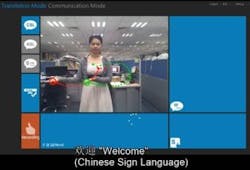Kinect-based sign language interpretation
What started out as a game has become so much more.
Okay, so by now you are well aware of some of the more unique applications of the Microsoft Kinect. If you aren’t, here are just a few:
- Kinect will be used to perform surgery
- Tele-rehabilitation booming with Kinect
- Can Oculus Rift and Kinect revolutionize virtual reality?
The latest innovative use of the Kinect involves researchers from Microsoft Research Asia using the device’s body-tracking abilities to perform sign-language recognition. By tracking the position of the user’s hands, many signs can be detected instantly by using the group’s 3D trajectory matching algorithm. Check out the video here:
The system consists of two modes, the first of which is translation mode, which translates sign language into text or speech. This includes isolated word recognition and sentence recognition. The raising and putting down of hands is defined as the “start” and the “end” of each sign language word to be recognized. The system gives the recognized rank-5 candidate works in the bottom region of the interface, and if the rank-1 word is not correct, the signer can adjust the results by manual interaction.
The second mode is communication mode, in which a non-hearing impaired person can communicate with the signer through an avatar. The impaired person can make an immediate response through signing, and the system translates the answer into text.
Once again, an extremely cool and practical application of the Microsoft Kinect that makes you wonder if the developers of the initial model had any inclination that the product would branch out as it has. Another thing that may make you wonder—I am, anyway—is what courtroom sign language interpreters are thinking of this technology. Probably akin to the way that a farmhand might think of this.
About the Author

James Carroll
Former VSD Editor James Carroll joined the team 2013. Carroll covered machine vision and imaging from numerous angles, including application stories, industry news, market updates, and new products. In addition to writing and editing articles, Carroll managed the Innovators Awards program and webcasts.
